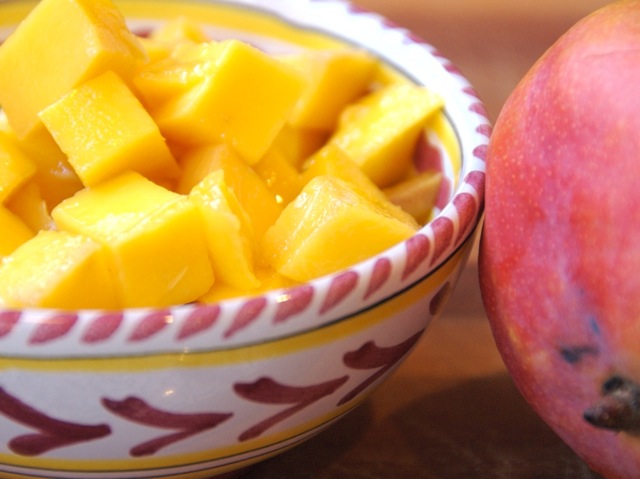
reference-image, l
(article, Rachel Rappaport)
[%adInjectionSettings noInject=true] Growing up, I can recall seeing mangoes at the market only a handful of times, and they were so expensive that buying one seemed a risky endeavor. How would I know when it was ripe? What should I do with it? And, worst of all, what if I didn't like the taste? Nowadays, fortunately, delicious mangoes are available at most supermarkets. But they can still be a tricky fruit to assess in the store and consume at home. h3. Varieties Thousands of varieties of mangoes are grown all over the world; most of the mangoes available in the U.S. come from Latin America. Some mangoes are almost as small as a Key lime, while others can be the size of a newborn baby. And their flavors can range from sweet and spicy to tropical, citrusy, and floral. [[block(sidebar). h1.Featured recipes]] Most U.S. supermarkets carry at least one or two types of mangoes, generally the Tommy Atkins and Ataulfo (often marketed under the name Champagne) varieties. Ethnic markets often have more selection, with four or five types of mangoes in the produce bins. For smooth dishes like soups, drinks, or desserts, choose the smooth-fleshed Champagne. The Tommy Atkins is a medium-fiber mango, and thus a good choice for main-course recipes; medium-fiber mangoes hold their shape a little better than the smooth (i.e., less fibrous) varieties. Fiber is important if you're going to cook the mango or make a dish, such as a fruit salad or salsa, in which you want the fruit to hold its shape. Smooth-fleshed mangoes, though delicious eaten on their own, have a tendency to melt into the other ingredients when heated or cut finely. [%image knife float=right width=300 credit="Photo © Culinate" caption="To make mango cubes, begin by scoring a mango half with a knife."] h3. Ripeness A mango is ripe when it’s fragrant, gives slightly to the touch, and is heavy for its size. Normally, if a mango is not quite ripe you can allow it to ripen gradually on the counter, but you can also accelerate the process by placing it in a paper bag with an apple or banana and leaving it on the counter overnight. Of course, unripe mangoes can be turned into wonderful curries and salads; they add a bit of tartness, and the cubes hold their shape even after cooking. If a mango ripens before you want to eat it, it can be refrigerated for another week. You can extend its life even further by freezing cubed mango or mango purée. [%image promo-image float=right width=300 credit="Photo © Culinate" caption="Finish by slicing the cubes off the mango skin with a spoon or paring knife."] h3. Cutting a ripe mango Position the mango on its end, and, being careful to avoid the big pit, slice off one side. Use the tip of your knife to score vertical lines into the mango half. Do not go all the way through the skin. Pivot and repeat to form little cubes. Place your spoon between the skin and the flesh and scoop out the cubes, or use a paring knife to loosen them from the skin. You can also use a paring knife to cut away flesh from the pit of the mango. p(bio). Rachel Rappaport lives in Baltimore. For more detailed instructions on cutting up a mango, refer to her blog, Coconut & Lime. *Also on Culinate: Sona Pai's article about mangoes from India.

reference-image, l

promo-image, l

knife, l